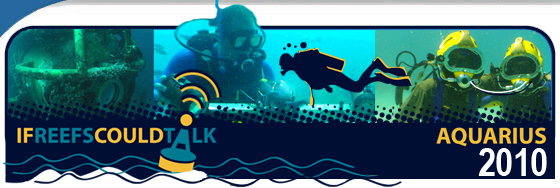Error processing SSI file
|
Aquarius 2010 Expedition Blog:
Oct. 15, 2010
By Chris Taylor, Ecologist
Center for Coastal Fisheries and Habitat Research
NOAA Ocean Service, Beaufort, NC
 |
| Brian Degan snorkeling through the dense mangrove roots. Click the image for a larger view. (Photo: Chris Taylor) |
All of our gear (6 crates of sonar equipment) arrived with us at the NURC bunkhouse Oct. 4. We had prepared for a busy mission of daily and evening surveys of fishes around Conch Reef using a combination of split-beam sonar and DIDSON imaging sonar along with our tried-n-true scuba visual fish surveys.
Winds settled and we finally got out to French Reef and eventually Conch Reef. Coordinating the diving, deploying the DIDSON sonar and conducting split-beam sonar surveys, all in a four hour expedition, was no small feat. Diving the reefs of the Florida Keys Marine Sanctuary was like being a kid in the candy store for Brian and me: great visibility, abundant fish, diverse bottom habitats. We were able to set up the DIDSON at the edge of the reef and record about three hours of continuous footage during dusk and into the sunset. Huge schools of mixed species moved all around the reef and surrounding sand and seagrass habitats. Seeing this first hand at dusk, especially, provided a new perspective of the reef and how fish are using these habitats.
 |
| Coral reef and fish near the Aquarius. Click here to view the video. |
We are working to take some of the mystery out of fish movement and habitat use in coral reefs. We know that fish are constantly on the move, between day and night, across seasons, years and throughout their lives. Using these SONAR technologies is helping us to think more like a fish and understand how they use the mosaic of habitats in coral reef ecosystems. The better we can we can link the otherwise disparate "parts" that make up the entirety of the coral reef ecosystem, the better we can enjoy, manage and conserve the ecosystems that support our living marine resources.
 |
| Brian Degan counts fish moving in front of the DIDSON. Click the image for a larger view. (Photo: Chris Taylor) |
Our work on this mission would not be possible without help from many people. Thanks to Kevin Boswell with Louisiana State University and Laura Kracker from NCCOS, Charleston, SC for loaning us the DIDSON, frame and battery pack and to Soundmetrics for their support during the mission. A special thanks to Pennekamp State Park for allowing us access to the Park. And finally to the staff of the Florida Keys Sanctuary for providing a boat and and UNCW for providing us boats, a home base and all the needed resources to conduct this work. Looking forward to returning soon!
|








